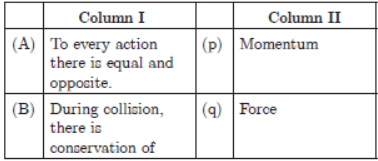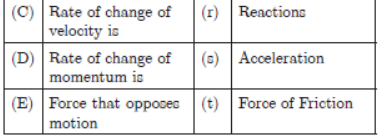Please refer to Force And Laws Of Motion MCQ Questions Class 9 Science below. These MCQ questions for Class 9 Science with answers have been designed as per the latest NCERT, CBSE books, and syllabus issued for the current academic year. These objective questions for Force And Laws Of Motion will help you to prepare for the exams and get more marks.
Force And Laws Of Motion MCQ Questions Class 9 Science
Please see solved MCQ Questions for Force And Laws Of Motion in Class 9 Science. All questions and answers have been prepared by expert faculty of standard 9 based on the latest examination guidelines.
MCQ Questions Class 9 Science Force And Laws Of Motion
OBJECTIVE QUESTIONS
Question. If A and B are two objects with masses 6 kg and 34 kg respectively, then
(a) A has more inertia than B
(b) B has more inertia than A
(c) A and B have same inertia
(d) none of the two has inertia.
Answer
B
Question. A body, whose momentum is constant, must have constant
(a) force
(b) velocity
(c) acceleration
(d) all of these
Answer
B
Question. Swimming is possible on account of
(a) First law of motion
(b) Second law of motion
(c) Third law of motion
(d) Newton’s law of gravitation
Answer
C
Question. If a body is moving alone a constant speed, it may be assumed that
(a) a net force is pushing it forward
(b) the sum of only vertical forces is zero
(c) the buoyant force is greater than gravity
(d) the sum of all forces is zero
Answer
D
Question. The inertia of a moving object depends on
(a) momentum of the object
(b) speed of the object
(c) mass of the object
(d) shape of the object
Answer
C
Question. The momentum of a body of given mass is proportional to its
(a) velocity
(b) size
(c) shape
(d) all of these
Answer
A
Question. A cannon after firing recoils due to
(a) conservation of energy
(b) Newton’s third law of motion
(c) Newton’s first law of motion
(d) none of these
Answer
B
Question. Identify the correct statement(s).
1. To accelerate the motion of an object, a balanced force is required.
2. Balanced forces do not change the state of rest or of motion of an object.
3. Balanced forces do not produce any acceleration, they can change the shape or size of the body.
(a) 1 and 2
(b) 2 and 3
(c) 1 and 3
(d) None of these
Answer
B
Question. A body is accelerating in a straight line. The unbalanced force acts
(a) in the direction of motion of the body.
(b) in a direction opposite to the direction of motion.
(c) in a direction perpendicular to the direction of motion of the body.
(d) none of these
Answer
A
Question. A man getting down a running bus, falls forward because
(a) due to inertia of rest, road is left behind and man reaches forward
(b) due to inertia of motion upper part of body continues to be in motion in forward direction while feet come to rest as soon as they touch the road
(c) he leans forward as a matter of habit.
(d) of the combined effect of al the three factors stated in (a), (b) and (c)
Answer
B
Question. A cannon after firing recoils due to
(a) conservation of energy
(b) backward thrust of gases produced
(c) Newton’s third law of motion
(d) Newton’s first law of motion
Answer
C
FILL IN THE BLANK
Question. Application of a force changes the ………. of an object.
Answer
velocity
Question. If there are several forces on an object, its acceleration depends on its mass and the ………. force.
Answer
net unbalanced.
Question. An object moving at constant speed is in a state of ……….
Answer
equilibrium
Question. ………. is equal to change in momentum.
Answer
impulse
Question. In any interaction between two or more isolated objects, the total ………. does not change.
Answer
momentum
Question. The SI unit of force is the …………
Answer
Newton
Question. The change in the velocity of an object is proportional to the ……… applied to it.
Answer
impulse
TRUE/FALSE
Question. A body can be in equilibrium under the action of three coplaner forces.
Answer
True
Question. It is easier to start motion in a lighter body than a heavier body.
Answer
True
Question. Action and reaction act on the same body.
Answer
False
Question. If particle is initially at rest then it moves in direction of net force.
Answer
True
Question. Particle is at rest, if force is zero.
Answer
False
Question. Action and reaction force acts on the same object.
Answer
False
MATCHING QUESTIONS
Question.


Answer
(A) (r), (B) (p), (C) (s), (D) (t), E (q)
ASSERTION AND REASON
Question. Assertion : A quick collision between two bodies is more violent than a slow collision, even when the initial and the final velocities are identical.
Reason : The rate of change of momentum determines the force.
Options:
(a) Both assertion and reason are true and reason is the correct explanation of assertion.
(b) Both assertion and reason are true but reason is not the correct explanation of assertion.
(c) Assertion is true but reason is false.
(d) Both Assertion and Reason are false.
Answer
A
Question. According to law of inertia (Newton’s first law), when cloth is pulled from a table, the cloth come in state of motion but dishes remains stationary due to inertia.
Assertion : When a firefly hits a bus, each of them exerts the same force.
Reason : Firefly has more mass as compared to the windshield.
Options:
(a) Both assertion and reason are true and reason is the correct explanation of assertion.
(b) Both assertion and reason are true but reason is not the correct explanation of assertion.
(c) Assertion is true but reason is false.
(d) Both Assertion and Reason are false.
Answer
C
Question. Assertion : Force required to accelerate a mass in two perpendicular directions is never same.
Reason : The presence of g will not influence the acceleration.
Options:
(a) Both assertion and reason are true and reason is the correct explanation of assertion.
(b) Both assertion and reason are true but reason is not the correct explanation of assertion.
(c) Assertion is true but reason is false.
(d) Both Assertion and Reason are false.
Answer
C
Question. Assertion : If the net external force on the body is zero, then its acceleration is zero.
Reason : Acceleration does not depend on force.
Options:
(a) Both assertion and reason are true and reason is the correct explanation of assertion.
(b) Both assertion and reason are true but reason is not the correct explanation of assertion.
(c) Assertion is true but reason is false.
(d) Both Assertion and Reason are false.
Answer
C
Question. Assertion : While walking on ice, one should take small steps to avoid slipping.
Reason : This is because smaller steps ensure smaller friction.
Options:
(a) Both assertion and reason are true and reason is the correct explanation of assertion.
(b) Both assertion and reason are true but reason is not the correct explanation of assertion.
(c) Assertion is true but reason is false.
(d) Both Assertion and Reason are false.
Answer
A
Question. Assertion : A table cloth cannot be pulled from a table without dislodging the dishes.
Reason : Newton’s second law of motion gives definition of inertia.
Options:
(a) Both assertion and reason are true and reason is the correct explanation of assertion.
(b) Both assertion and reason are true but reason is not the correct explanation of assertion.
(c) Assertion is true but reason is false.
(d) Both Assertion and Reason are false.
Answer
D
Question. Assertion : Change in momentum is impulse.
Reason : Impulse is the area between (F-t) graph and time axis.
Options:
(a) Both assertion and reason are true and reason is the correct explanation of assertion.
(b) Both assertion and reason are true but reason is not the correct explanation of assertion.
(c) Assertion is true but reason is false.
(d) Both Assertion and Reason are false.
Answer
B
Question. Assertion : From Newton’s second law of motion, impulse is equal to change in momentum.
Reason : Impulse and momentum have different SI units.
Options:
(a) Both assertion and reason are true and reason is the correct explanation of assertion.
(b) Both assertion and reason are true but reason is not the correct explanation of assertion.
(c) Assertion is true but reason is false.
(d) Both Assertion and Reason are false.
Answer
D
Question. Assertion : A quick collision between two bodies is more violent than a slow collision, even when the initial and the final velocities are identical.
Reason : Because the rate of change of momentum which determines the force is greater in the first case.
Options:
(a) Both assertion and reason are true and reason is the correct explanation of assertion.
(b) Both assertion and reason are true but reason is not the correct explanation of assertion.
(c) Assertion is true but reason is false.
(d) Both Assertion and Reason are false.
Answer
A
Question. Assertion : A large number of concurrent forces acting at the same point of the object, then the object will be in equilibrium, if sum of all the forces is equal to zero.
Reason : Equilibrium of a particle in mechanics refers to the situation when the net external force on the particle is non-zero.
Options:
(a) Both assertion and reason are true and reason is the correct explanation of assertion.
(b) Both assertion and reason are true but reason is not the correct explanation of assertion.
(c) Assertion is true but reason is false.
(d) Both Assertion and Reason are false.
Answer
C